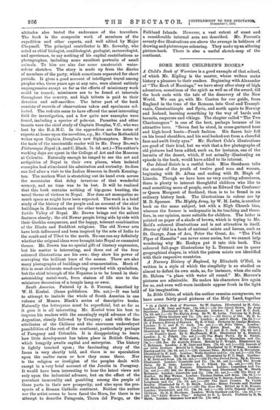ASIA AND SOUTH AMERICA.
Through ShOn-San. By R. S. Clark and A. de C. Sowerby. (T. Fisher Unwin. 25s. net.)—The expedition undertaken by Mr. Clark, of New York, in 1908-9 has an interesting record in this volume, which is intended to be not only an account of travel, but also a contribution to science. Starting by rail from Peking, the expedition took the road westward from the terminus at Tai-yuan-fu towards the Yellow River. Then it turned southward along the river basin and again westward as far as Lan-chou, almost on the border of Tibet, and back by somewhat different roads. About two thousand miles in all were traversed through the provinces of Shansi, Shensi, and Kansu. Since the route was seldom out of touch with passable roads, and even telegraph wires, it may seem less adventurous than many, but the fact that the Indian surveyor (lent by the Survey of India) was murdered by Chinese natives when taking observations away from his party, proves that it was more than adventurous enough ; no redress was ever made for the death of this British subject. The cold winter in the high
altitudes also tested the endurance of the travellers. The book is the composite work of members of the expedition and other experts, and well edited by Major Chepmell. The principal contributor is Mr. Sowerby, who acted as chief biologist, ornithologist, geologist, meteorologist, and sportsman, to say nothing of his capital contributions as photographer, including some excellent portraits of small animals. To him are also due some amateurish water- colour sketches. The story is made up from the diaries of members of the party, which sometimes separated for short periods. It gives a good account of intelligent travel among peoples who, three years ago at any rate, were almost entirely unprogressive except so far as the efforts of missionary work could be traced; missioners are to be found at intervals throughout the country, and high tribute is paid to their devotion and self-sacrifice. The latter part of the book consists of records of observations taken and specimens col- lected. The rodents seem to have offered the most interesting field for investigation, and a few quite new examples were found, including a species of pole-cat. Parasites and other insects were the chief study of Captain Douglas, V.C., who was lent by the R.A.M.C. In the appendices are the notes of experts at home upon the novelties, e.g., Mr. Charles Rothschild writes upon Captain Douglas's new Siphonaptera. More to the taste of the unscientific reader will be Mr. Percy Brown's Picturesque Nepal (A. and C. Black. 7s. 6d. net.)-The author's working days are spent in the College of Art and the Museum at Calcutta. Naturally enough he longed to see the art and antiquities of Nepal in their own places, when isolated examples had stimulated his admiration and curiosity. So does one feel after a visit to the Indian Museum in South Kensing- ton. The modern West is stretching out its hand even across the mountains that delay invasions of that wonderful scenery, and no time was to be lost. It will be realized that this book contains nothing of big-game hunting, the usual theme of visitors to Nepal. Nor does art monopolize so much space as might have been expected. The work is a brief study of the history of the people and an account of the chief buildings in Katmandu and the other towns which lie in the fertile Valley of Nepal. Mr. Brown brings out the salient features clearly; the old Newar people living side by side with their Gurkha conquerors, and the happy, tolerant combination of the Hindu and Buddhist religions. The old Newer arts have both influenced and been inspired by the arts of India to the south and of Tibet to the north. No one can say definitely whether the original ideas were brought into Nepal or emanated thence. Mr. Brown has no special gift of literary expression, but his matter is interesting, and three out of the four coloured illustrations are his own : they show his power of conveying the brilliant hues of the scenes. There are also many photographs of buildings and ornamentation. Much of this is most elaborate wood-carving crowded with symbolism, but the chief triumph of the Nepalese is to be found in their astonishing metal-work, from statues of life size to the miniature decoration of a temple lamp or ewer.







































































 Previous page
Previous page